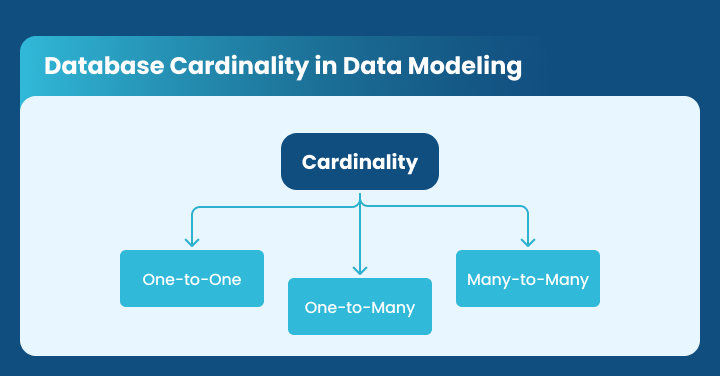What is Database Cardinality?
Database cardinality provides a framework for understanding relationships between tables. It plays a critical role in database design and in how quickly queries get results.
Cardinality takes on different meanings in the context of data modeling and query optimization.
Database Cardinality in Data Modeling

In the context of data modeling, cardinality refers to how two tables in a database relate to one another; more specifically, how many rows on one table are related to how many rows in another table.
There are three types of cardinality in the context of Data Modeling:
- One-to-One
- One-to-Many
- Many-to-Many
Let us look at each one of these in detail.
One-to-One
A one-to-one (1:1) relationship is the least common occurrence in databases. It occurs when one row in a table relates to precisely one row in another table.
For example, if Table A represents Student IDs and Table B represents Student Names, then each row in Table A can only be linked to one specific row in Table B.
Key Point: To implement a one-to-one relationship, you can use a primary key or a unique constraint on both tables and a foreign key to link them.
One-to-Many
A one-to-many (1:N) relationship defines a situation where one row in a specific table is related to multiple rows in another table. A one-to-many relationship is one of the most common forms of database cardinality.
For example, Table A represents Student IDs, and Table B represents a list of the institution’s departments. In this scenario, each student can only be part of one department, but each department can have zero or more students.
Key Point: To implement a one-to-many relationship, you can use a primary key on the one side and a foreign key on the many sides.
Many-to-Many
A many-to-many relationship is a situation where multiple rows in one table can related to multiple rows in another table. This form of relationship is complex to decipher as is, and it is often easier to break down this multiple one-to-many relationship.
For example, consider Table A, which represents a list of students, and Table B, which represents a list of courses. Here, a single student can enroll in multiple courses, and each course can have either zero or multiple students enrolled for it.
Key Point: To implement a many-to-many relationship, you need to use a third table, called a junction table or an associative table, that stores the pairs of related rows from both tables.
How does Database Cardinality help in Data Modelling?
Database cardinality plays two crucial roles in data modeling. First, it helps in accurately defining the relationship between two tables (entities) in a database, which in turn makes it easier to understand.
Second, it helps normalize the database (the process of organizing the data to mitigate data redundancies, inconsistencies, and other anomalies). This improves data quality, leading to efficient query performance.
Take, for example, an “Orders” table with an “Item ID” field. This table allows multiple item IDs in a single order (many-to-many without a junction table). This poor cardinality leads to data redundancy (storing the same item ID multiple times) and difficulty retrieving specific order details (complex queries needed).
If we introduce a separate “Order Items” table with “Order ID” and “Item ID” (that properly defines the one-to-many relationship), we eliminate redundancy, which in turn reduces the complexities of the queries. The result – improved efficiency
Database Cardinality in Terms of Query Optimization
In the context of query optimization, database cardinality alludes to the uniqueness of the values of a column in comparison to the number of rows in a table.
Database cardinality in terms of query optimization is of three types:
- High Cardinality
- Normal Cardinality
- Low Cardinality
High Cardinality
High cardinality refers to a column that contains largely unique values. Columns that contain values such as Student/Employee IDs, Names, and email addresses are considered to have high cardinality.
Normal Cardinality
Columns with fairly uncommon values, such as the name of roads or streets, vehicle types, or model names, are referred to as columns with normal cardinality.
Low Cardinality
Columns that consist of very few unique values, such as gender, yes/no values, vehicle colors, and so on, are referred to as having a low cardinality.
How Does Database Cardinality Help in Query Optimization?
In terms of query optimization, database cardinality helps in Cardinality Estimation – a process that helps query optimizers determine or estimate the number of rows a query would return.
This, in turn, helps query optimizers design query plans that perform better with minimal resource utilization.
For example, when dealing with low cardinality (few distinct values), the optimizer may favor index scans to retrieve data efficiently. Conversely, a high cardinality estimate (many rows expected) might suggest a full table scan is more efficient.
Automate your Database and IT Operations
As you can see, data cardinality plays a vital role in data modeling and query optimization. If complex databases and slow queries are a challenge, understanding cardinality is a step toward solutions.
